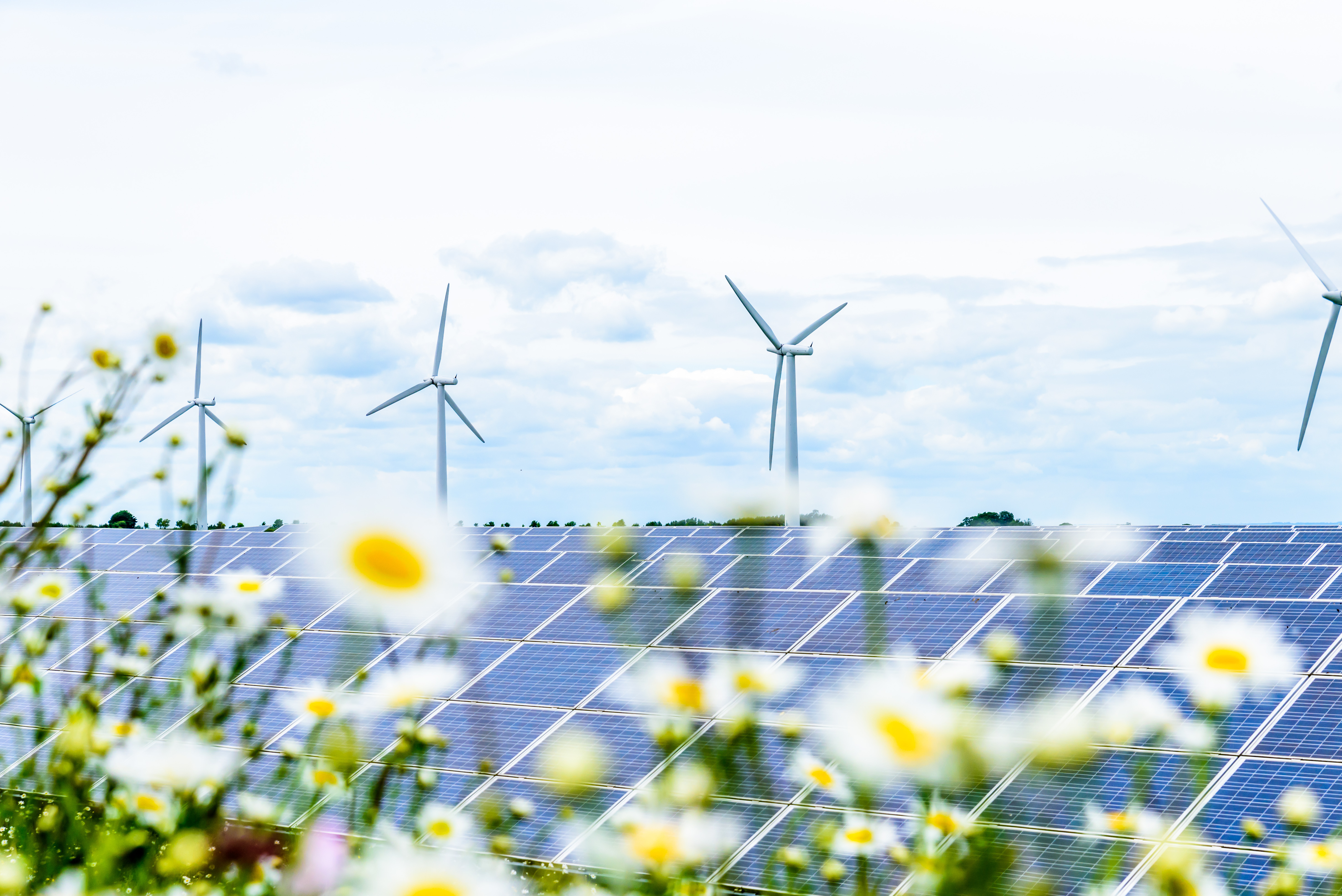
A quick poll of the 140 people attending our recent conference highlighted that the primary obstacle to decarbonising the electricity systems by 2035 is grid capacity and stability.
The planning and consenting process came in second. Policy being unfavourable and uncertain came further back in third. No surprises there.
Land acquisition and the availability of capital and finances were perceived to be less of an issue. This is great progress, considering that the availability of capital and finances was a major barrier 10-15 years ago.
Anti-wind campaigners are also no longer a major issue, making it easier to make progress towards decarbonising the electricity systems.
Can Biodiversity and renewables work in harmony?
The conversation came round to questioning whether there was a conflict between natural capital and biodiversity and the development of renewable energy projects and infrastructure. Clearly, these two goals should be connected to develop a low carbon and high nature future.
Nature-based solutions such as woodland restoration, seagrass creation and salt marsh creation are just some of the ways we can make this happen. However, in reality, there is still a conflict between the two due to the planning process, which is problematic for nature conservation due to the need to actively develop renewable energy sources to combat climate change.
In order to make real progress, we need to actually take a look at the joined-up approach of the energy system and build a nature recovery network across the country.
This can only be achieved by land managers working in partnership with industry to find strategic solutions that enable large scale developments. By doing this, we can ensure that the goals of nature conservation and renewable energy development can be achieved together, rather than in opposition.
Challenges for the National Grid and District Network Operators (DNOs)
Grid connection capacity is the top issue, but what are the challenges for the National Grid and DNOs and their role in meeting our targets?
They need to look at how they can innovate and collaborate to ensure they can find ways of connecting projects earlier than the delivery dates set out by the National Grid for reinforcement works. But whilst increasing capacity on the network, the DNOs are also challenged with ensuring there are enough skilled people to work on the projects. I’d recommend reading Hugh Taylor’s article to find out more about the issues surrounding grid connectivity.
Opportunities, challenges and solutions
From an investor’s perspective it might just be worth clarifying what the scale of the potential problem is. If we are to meet the ambition of the UK's renewable energy targets, then we need to look at solutions which can provide the capacity needed to meet the anticipated fourfold increase in the demand for renewable energy. Storage, grid factors, planning and policy all have an important role to play in helping us achieve this.
Investment remains available and there are opportunities for investors to benefit from co-locating renewable assets and storage together in order to improve returns. The challenge now is to work together to make this ambition a reality.
With (my previous) developer hat on, I know they are constantly looking for new ways to solve the biggest challenges we face in the energy industry.
Their main focus is on grid services and grid stabilisation, as well as balancing supply and demand through storage. To help with grid stabilisation, some developers are looking into creating ‘grid parks’ which act as a power station turbine without the power station.
They are also looking into storage solutions, such as batteries which can help with frequency stabilisation and pumped hydro, which can store energy over days and weeks. Excitingly, I know of one developer who is working on a utility-scale project in Scotland which can store enough energy for 3 million homes for 24 hours.
Green hydrogen as a fuel source is also being explored, which can bring forward developments that don’t have grid connections. There is a project in West Wales, which will use solar turbines to generate power that can then be stored as green hydrogen. This could be used to power Welsh public transport in areas that aren’t suitable for electrification.
With this dedication to finding new, innovative solutions to the challenges we face in the energy sector and by using grid services, storage solutions and green hydrogen, we will be able to bring forward many more renewables’ projects.
Shining a light on the biodiversity benefits of solar
As the world strives to become more sustainable, solar farms and their potential biodiversity net gain (BNG) benefits deserve a closer look. While there is still some public opposition to solar farms, much of it is based on a lack of understanding of the potential benefits to the environment.
Solar farms can provide a high percentage of BNG, making it a viable option for land that could otherwise be overlooked. However, solar farms are often seen as a mechanical intrusion into the natural world, leading to objections from the public. However, the UK currently has more than five times the amount of land allocated to golf courses than it does to solar farms*. Agrivoltaics are also a real proposition, allowing solar photovoltaic power generation and agriculture to simultaneously use the land.
It's time to reset the debate and our relationship with the natural world if we are to generate the amount of energy we need for the coming decades. This means coming up with a comprehensive land use framework that takes into account energy, food, nature, nutrients, and housing. This is a debate that DEFRA is currently engaging in, and one we need to take seriously if we are to make a real difference in the fight against climate change.
Substations’ capacity increase – who picks up the tab?
The problem of how to fairly divide the cost of substation capacity increases among multiple customers is a complex one. As a result of changing customer needs, DNOs have had to try and find solutions that enable the spread of costs in a fair and equitable way.
Take, for example, the case of six customers who collectively need to pay for a £10 million substation upgrade. If one customer drops out, then the remaining customers must pick up the tab. This domino effect could have a significant impact for the remaining customers, particularly if the customer who drops out had the biggest contribution.
Ultimately, the only real solution to this issue is to modify existing policies and regulations in order to socialise the costs at the distribution or transmission level. This way, the responsibility and cost of substation capacity increases is shared across all customers and no single customer is unfairly burdened.
The complexity of this issue means that we must continue to search for solutions that are fair to all customers and provide a balance between the needs of the customers, the safety of the network, and the cost of upgrades.
The charged debate about battery manufacture
As a sector, we feel a great responsibility to ensure that our supply chains are ethical and sustainable. We recognise concerns about the supply chain and possible environmental and social impacts of extracting, transporting and manufacturing batteries. We should be committed to ensuring they are being ethically sourced. We have to investigate our supply chain, investigate subcontractors, and ensure that the people involved have proper working conditions and are being paid the right amount. We need to ensure that our supply chain is doing right by the environment and the people involved.
Keeping the lights on
As someone who works in the energy industry, I'm frustrated when I watch the news and hear about potential blackouts, yet I never hear from the people who could really provide insight into the issue: the grid operators. The media loves to talk about blackouts but fails to address the underlying concerns of the industry.
While it's likely that a capacity margin shortfall could still present itself, it's important that the DNOs are part of the conversations surrounding blackouts in order to provide the necessary insight and instruction and be part of this critical conversation if the lights flicker or go out.
My thanks to Matt Heard, Director of Strategy, Natural England; Steve Halsey, Distributed Energy Resources Development Manager, UK Power Networks; Jenny Thompson, Senior Land Manager, Statkraft and; Peter Bolton, Investment Director for Renewable Energy, Gresham House. Their knowledge and insight are fascinating and should provide a clear steer to Government on how it can help renewables’ developers deliver on our green ambition.
*Carbon Brief

























